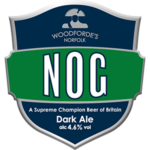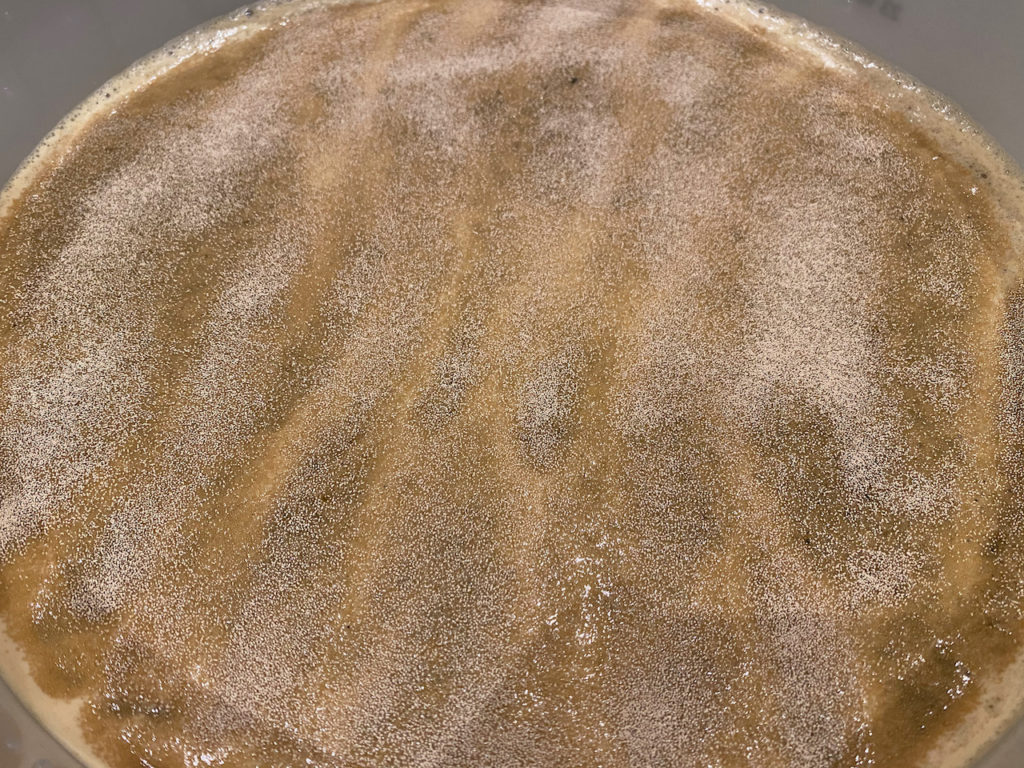I wondered what LC stood for as I popped the cap off a Nog just now. Checking back on the bottling notes I see that LC means Loose Cap and I really should have tried twisting it to see if it was still loose before opening. Oh well, maybe next time. For what it’s worth the carbonation is just fine, and probably no different from the last one I tried. Maybe I’ll do a back-to-back comparison with the next LC bottle I find. Maybe I’ll forget. Again.
Nog
| Ref | 2021-01 Nog | Brewer | Woodforde's |
|---|---|---|---|
| Style | Dark Ale | Type | Beer, kit |
| Started | Thu 14th Jan 21 | Status | Archived, |
| Packaged | Sun 31st Jan 21 | Fermenter | Plastic Bucket |
| Handle | 2021-01 Nog |
|---|---|
| Brewer | Woodforde's |
| Style | Dark Ale |
| Type | Beer, kit |
| Fermenter | Plastic Bucket |
| Status | Archived, ABV |
| Started | Thu 14th Jan 21 |
| Packaged | Sun 31st Jan 21 |
It’s been 14 days in the cold, should have cleared enough by now to risk taking a sip or two.
Update 02 March: this was supposed to be ready on 24 Feb, but because I’m a pig I’d already necked a couple by that point and given away a couple more since.
All partakers alive and well. 😁
I opened one of these two days ago under a mixture of curiosity / impatience, and was pleasantly surprised at how good it was. So much so in fact that I decided I need another one tonight.
The aroma is sweet like Honey Porter and there’s a touch of mellow maltiness to it, but also a hint of iron contributing to well-rounded mouthfeel with lingering notes of caramelised nuts. It’s better than a kit brew has a right to be, and I’m wondering if I’m seeing this at its peak of if the best is yet to come. As it stands I’ll gladly brew this one again, and wouldn’t change a thing.
To be continued …
Instructions call for two days in the warm after bottling, but I’m going to give it a week based on nothing more than Wherry (which shares the same brewer / instructions) being a little sweet and a little flat. That one had 3 days between bottling and conditioning, let’s see what happens when we give Nog a bit longer. Of course there’s no straight comparison since Wherry used carbonation drops and Nog was batch-primed with dextrose, but hey … we’ll see.
Edit: actually, I was three days late moving this one out due to one thing and another, so she’s had 10 days in the warm. Garage is plenty cold enough right now at just 1 ℃, let’s sit tight and check in after a couple of weeks.
17 days after starting primary and Nog is finally ready to drop anchor. Gravity looked to be steady at 1.014 as it was two days ago, so I decided to call time and get her put away.
Only after I’d washed the bottles (first time using Chem San rinse instead of Milton) did I notice that I was out of carbonation drops, so I thought I’d have a go at batch priming – why not make it two firsts in one night. The Brewer’s Friend calculator recommended 91.1g of table sugar for 20 litres of beer at 20℃ in order to achieve 2.0 vols, which is the base of what’s recommended for Porter and Stout and the upper end for British Ale.
I had about 20 litres and no table sugar, so I used 100g of brewing sugar (Dextrose?) instead since it dissolves quickly. Measured it out into a mug which was flushed with boiled water, then added it to a clean FV followed by Nog from the original FV, using the bottling wand and avoiding aeration whenever possible. A slight stir was necessary once half of the beer was transferred across since I didn’t want to risk uneven carbonation, but I think I did OK.
36 x 500 ml brown bottles were filled from the secondary bucket without issue, capped with black crowns, batches of 8 at a time. I had a good little production line going (getting slick now) and couldn’t help but try a few of the caps to see if they’d spin. Nearly all of them did, some more easily than others. That’s always been the case, but at the back of my mind I’m wondering if they were a bit easier this time around than before. What was different? Well, I was only capping the bottles with one movement, whereas before I’d spin them 90 degrees after the first ‘crimp’ and then give them another squeeze. I also soaked the caps in Chem San (ChemSan? Chem-San?) for the first time instead of Milton, and this no-rinse sanitiser does have a certain sappy quality when wet. Apparently that’s normal, as is the foam. Just ignore it and keep filling.
Once the beer was bottled and everything washed up we had dinner and watched a film, then maybe 3 hours later I went back to print labels and put them away for warm conditioning. At the back of my mind I was thinking about those spinning caps, so I took a permanent marker with me and resolved to identify any spinning caps with an LC so that I could see if there were any effects on carbonation at serving time. Trying each bottle in turn as I applied the label I found only 4 or 5 which would spin bare-handed, whereas before it was most of the batch. That’s tremendously positive, since I can attribute it to the caps being wet at bottling time, possibly aided by a slippery sanitising solution. The relevant labels were marked, and I’ll give them another spin before popping the caps when it’s time to serve. Have a gut feeling that they’ll all be rock-solid, and any perceived loss in carbonation will be shared between those marked LC and those not marked at all.
Same story as two days ago; slight airlock activity, slightly indecisive readings. The brew looks pretty much the same too, perhaps slightly better groupings between the islands of bubbles on the surface.
Where SG is concerned I’m going with 1.015 since that’s where we averaged over about 4 or 5 attempts – either way it’s not the magic 1.014 and it’s still moving. I’ll check back in a couple of days.
There’s still some minimal airlock activity but it’s been tailing off rapidly these past few days, and as we’re now at the 10 day point it’s time to check in with a gravity reading.
There was a bit of fizz in the trial which made readings tricky, but it looks like we’ve got between 1.015 and 1.016. Let’s go with the latter to be on the safe side, and that translates to 4.20% ABV against a target of 4.50%. Close, but no cigar.
Brew smells lovely and looks healthy too, some bubbles on the surface and dried remnants of Krausen on the inside of the FV. The sample tastes good with just a hint of sweetness that agrees with the reading in that she’s not quite ready yet. Let’s look in again 48 hours from now and see where she’s at.
Interesting to see that Wherry took 22 days to stabilise at 1.012 from 1.044, dropping just two points in the final 10 days. Nog is a touch darker and started at 1.048, so I’m expecting her to slow to a crawl around 1.014, which is the manufacturer’s recommended threshold for bottling – provided she’s stable at or below.
Kicking off another kit from Woodforde’s, this time it’s a dark red ale, possibly named after some sort of boat. There’s two cans of wort and two sachets of yeast, very little to go wrong here. I’m going to use Tesco’s Ashbeck bottled water throughout, see if I can get the gravity values and fermentation times closer to what they should be than I did with Wherry.
The 3.5 litres of boiling water on wort were followed with some almost-frozen bottles of Ashbeck from the garage, bringing the pitching temperature to 19.6 ℃. Initial gravity came in at 1.048.













